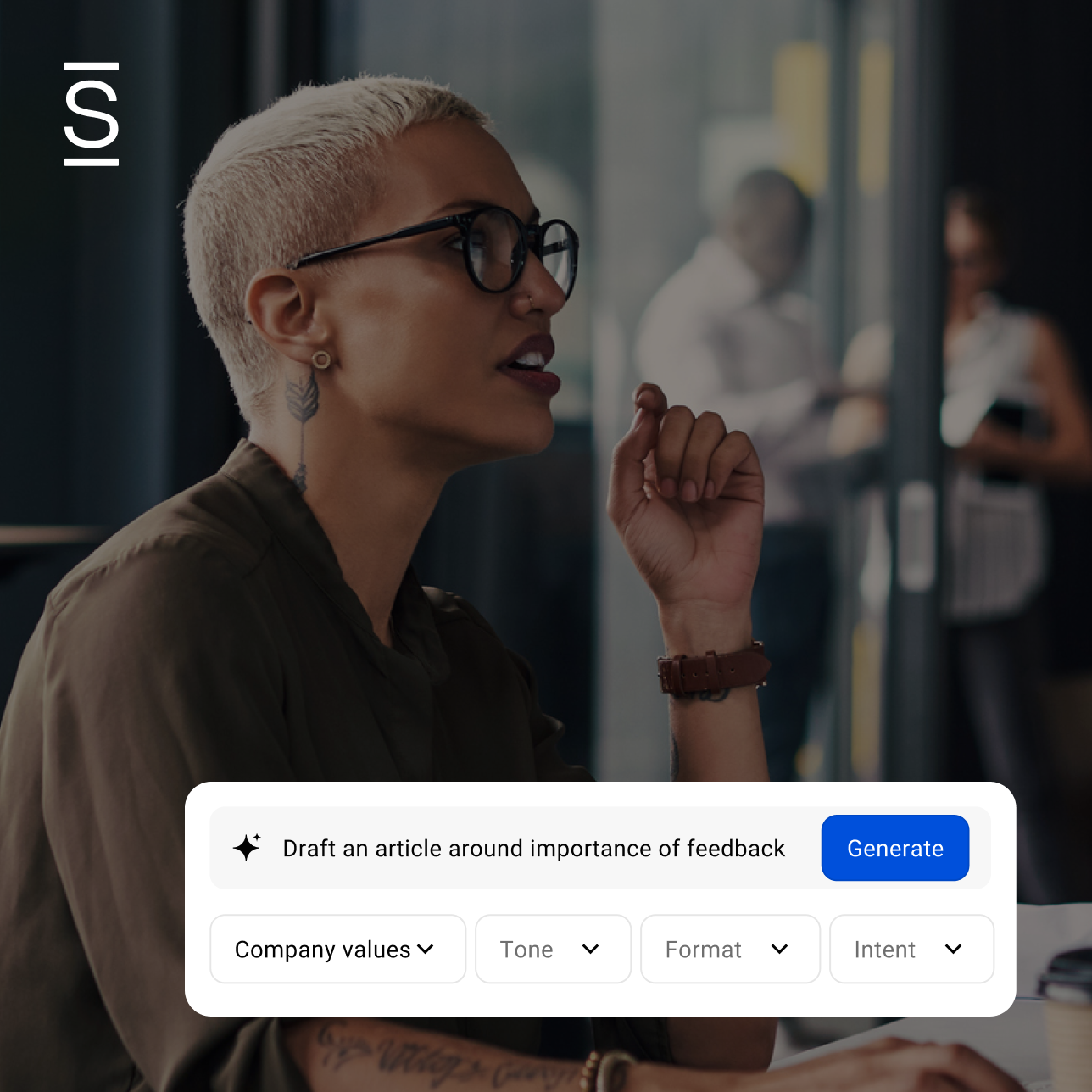There is an increasing demand from employees for organizations to support their professional development. On the other hand, companies perform better if they are active in the professional advancement of their workforce.
Taking deliberate measures to foster employee development in the workplace will set your enterprise apart attracting top talent and boosting your competitiveness in the market.
A study on employee efforts toward professional development found that a third do nothing to advance their careers. At the same time, 86% of professionals say they would switch employers if they were offered more professional development opportunities.
Employee development improves employee engagement by providing a sense of purpose, fostering connection and loyalty to the organization, and showing value and respect, leading to increased motivation.
In this guide, we’re going to discuss employee development including how to foster the culture, its benefits to both parties, how to know what your workforce needs, how to set up a professional development program, the challenges you must be prepared to face, as well as how to measure the success of your program so you can adapt and improve like the pros.
Understanding the Benefits and Challenges of Professional Development in the Workplace
You’ve heard that experience is the best teacher. However, while the employee’s daily experiences do add up to a substantial amount – making them more capable of doing the job – relying on experience alone isn’t a sound career development strategy.
Especially in the modern work environment, professionals need to keep learning to earn or maintain their employability. Employee development helps them acquire and hone relevant skills, stay updated on the current trends and requirements, and transition to higher levels in their careers.
Professional development isn’t just for the sake of the individual but also their employer and the people they serve. It boosts productivity and performance while at the same time assuring safety, value, and excellence to customers.
This is so important that professionals in some fields such as Finance and Healthcare must prove their continued development through certification. Sometimes ongoing learning and training is a prerequisite for keeping their job title, certificate, or license.
Employee development can take different forms. On-the-job training is provided to equip employees with skills for specific daily tasks such as using tools and technology. Professionals may also take online and offline classes to develop their skills.

Other skills may be earned through professional coaching and others may come through mentors and job shadowing. Employees can also learn during conferences, trade shows, networking events, and other opportunities coming their way.
Despite the many learning opportunities, many employees don’t take advantage. Studies quote a third of employees admitting to being complacent in their skill set and up to half being aware of their own inadequacy for their jobs.
Why is that?
Usually, professional development is a personal initiative – the professional sets and pursues their own goals without direct input from the employer. However, employers across the board are increasingly involved in their employees’ professional development.
Not only is employee development challenging when doing it the old-fashioned way (employee-led) but employers have a lot to gain by investing in the education of their workforces.
Benefits of professional development
Professional development helps workers remain on their feet amid shifting grounds. With the rapid rate of change in the modern workplace, complacency is death for a career. To survive, the employee must be agile and respond quickly to changes.
Being able to adapt gives them confidence about their job security, and this contributes to their performance and well-being.
Contrast that with the employee who is always worried about losing their job to a machine or a more qualified person. They are less excited to come to work, their morale throughout the day is low, and their daily output is below par. That person is no longer satisfied with their job.
A simple gesture from the employer is all it takes to turn things around. R, rather than leaving it to the employees to figure out how they can remain employed, showing them that the organization is committed to their advancement could be the hope they need to stay focused on the job.
And there are many benefits to the organization, stemming from the boost in employee engagement. The fear that would otherwise hinder productivity is turned into dedication, leading to improved performance.
A more skilled workforce is also more efficient and thus uses fewer resources to achieve the organization’s goals. Beyond that, it promotes innovation where employees are not just well versed with the existing systems but can also improve them creatively.
What’s more, employers can’t just replace their workforce for being under-skilled. The high turnover costs discourage wanton hiring and firing while the comparatively lower cost of upskilling favors employee retention.
A long-standing workforce is more attuned to the mission, is more loyal to the employer, and it’s essential in upholding the company culture.
That said, employers must be prepared to face some challenges that may stall the implementation of their professional development programs.
Challenges in fostering professional development
Employee development is an investment for the employer, and it has to contest for attention, funding, and implementation against other pressing needs. This means that organizations don’t always have the resources to put into training, classes, and other forms of employee education.
Employees may also miss out on professional development opportunities requiring time off their work. Faced with a choice between letting employees improve or learn new skills and taking care of urgent tasks that can be performed with the current skillset, the employer will often go with the latter.
Add to that the fact that the employee has other responsibilities outside work that may prevent them from taking up opportunities offered by their employer.
We see it in extreme cases where young women pause their careers to start a family. By the time they are back, they have remained stagnant in their career and aren’t even qualified for their old position anymore.

In more mild cases, missed opportunities look like this: An employee missing out on a conference because they were out handling more pressing matters; putting off coursework (especially if it’s e-learning) to meet a project deadline; and leaders passing up employee mentoring because they don’t have enough time. All these lost opportunities add up.
Further, professional development is still a matter of personal initiative. Employees who don’t see potential value in the learning opportunities may resist the program altogether. Thus, the employer must identify the existing needs and create a program that engages employees from the start.
Identifying Employee Development Needs
The employee development program should not be created simply at the employer’s whims. It takes a concerted effort to create one that ensures the prosperity of both parties, employers and their employees uniting to identify the needs.
A program created this way has a higher chance of success as both understand the goal and are bought in from the outset. Working together, they can ensure that the solutions offered align with the organization’s goals and the employee’s needs.
Identifying employee development needs should be a top-down operation with the managers leading the process. At the same time, the process should provide for a two-way interaction that not only accepts but also encourages employees to suggest solutions.
There are a few tips to ensure this happens.
Understand. It’s a huge mistake for the employer to assume they understand all a job entails just because it’s in their department. Even if you climbed your way up, so much might have changed already – hallo, we’re talking about upskilling for precisely that reason – that you must re-acquaint yourself to address the employee development needs.
Understanding what it takes to do a job successfully helps the employer set reasonable expectations for their staff. This is a great starting point to know if your employees require training in certain areas. When they fail to achieve the set goals, you can inquire deeper into the obstacles, and you just might find a skills gap.
To understand a job, first, know the optimal conditions for its performance. What skills are needed? Do employees have the best tools? Consult with other departments such as HR, IC, and IT to answer some of the questions. Next, you should know the challenges employees are facing in the job.
Ask. To understand different jobs, you can also directly ask the employees, especially about their work problems. For instance, an employee may tell you they need certification in a particular area to boost customer credibility.
Asking employees about their professional development needs can be the simple gesture that restores their confidence. Additionally, you can also get very direct answers on the employee development needs from asking them.
You can also be tactful about how you obtain this information. For instance, ask them about their career goals. Do they aspire for leadership positions in the company? You can also ask about their concerns in the workplace, such as job security, safety, and compensation/appreciation. Use techniques such as online surveys, video-based focus groups, and live interviews.
Monitor. Asking doesn’t guarantee all the answers, so you need to monitor employee interactions, activities, and outcomes. Employee interactions may provide clues into what they need to do their jobs, e.g., when they mention challenges.
Similarly, employee activities and behaviors may point you to unmet professional development needs. For instance, if they start running late and it turns out to be an issue with their time management skills or a steep learning curve for a project. Finally, monitor their performance.
Of course, for a large organization, you’re not just going to watch one employee at a time but instead use the records such as activity logs, performance metrics, and people analytics to identify patterns. You can also analyze employee notes from conversations with heads of department, HR, and on social media to identify skills gaps.
With modern employee experience technology, you can not only identify employee development needs but also address them effectively by establishing goals, measuring, and improving your program.
Establishing Measurable Goals and Objectives

Setting measurable goals and objectives for their professional development steers employees toward the outcomes they want. Attainable goals enhance a sense of purpose as the individual has something personal towards which they work in addition to the broader organization’s mission.
This boosts their engagement, making them more motivated and productive at work. At the end of the day, they acquire skills and competencies that can be channeled back into the organization. Beyond that, for the employer to know how the employee development program is working and how it can be improved, they have to determine success at the individual level.
How to establish professional development goals
To establish effective employee development goals, keep the following tips in mind.
Understand the end goals
Just like the organizational objectives are set by first looking at the end goal, professional development goals should be established with the individual employee end goals in mind. Sure, the program is aimed at helping employees prosper in their careers. But each employee has a different vision, and you need to know what that is before you can help them achieve it.
Identify growth areas
Once you know what they are aiming for, establish that they are on the right path then figure out what they need to take the next step. You can ask them to conduct a self-evaluation of their progress so far. Then supplement it with peer and managerial evaluations, i.e., how do their colleagues and managers rate their performance?
Set short-term goals
Armed with the previous information, you can now set a series of SMART goals to accomplish the end goals. Keep track of the progress, noting how personal initiative and the employee development program contribute to success.
Establish a timeline with milestones and celebrate the wins whenever you get the chance. This boosts morale and keeps the employee engaged with their professional development efforts and the organization at large.
How to evaluate the program
Employee development requires significant resources from the organization. All the stakeholders want to know that these resources will be used well. A regular evaluation of the program will keep the goals in mind, demonstrate its effectiveness, and ensure the optimum allocation of resources.
Evaluate one key aspect at a time
An employee development program can lead to various outcomes from changes in behavior, job satisfaction, and ultimately the attainment of professional objectives.
The success of the program can therefore be evaluated across different aspects. The most useful evaluations are highly focused. There are five aspects of professional development evaluation:
- Implementation examines the effectiveness of program deployment.
- Reaction examines the employee response to or perception of program activities.
- Learning examines the gains in knowledge and skills attributable to the program.
- Behavior examines the effect of the program on employee behavior and mindset.
- Impact examines the long-term outcomes of the employee development program.
Work with key stakeholders
Stakeholders include the employees, program financiers, decision-makers, policymakers, trainers, and others who have an interest in the results of the evaluation. Engaging them can yield critical support through broader buy-in and application of the findings.
Invite one or a few key people from each stakeholder group to help with the evaluation in different ways including providing required data, interpreting the results, and applying the insights. To this select group, describe the employee development efforts and goals to form the basis of the evaluation.
Also, define what you aim to accomplish with the evaluation (evaluation objectives) and the overarching questions you want to be answered from the evaluation.
Identify the key performance indicators
Performance indicators describe the extent to which the program has gone in achieving the desired outcomes. They inform “what” you measure during the evaluation and should correspond to the goals and objectives.
Each aspect of the employee development program has a range of indicators. Sample indicators include rate of training completion (Implementation), level of satisfaction (Reaction), confidence in applying new skills (Learning), adoption of new systems (Behavior), and promotion into higher responsibilities (Impact).
Collect relevant data
After determining what you shall measure, proceed to data collection. You will likely need both quantitative and qualitative data to evaluate each indicator effectively, the former demonstrating the amount of progress and the latter describing the events and explaining success/failure.
Thus, you will need multiple sources of data and consequently, a variety of data collection methods. Data sources include the different stakeholders, and the methods include surveys, focus groups, observation, and interviews.
Analyze and interpret the data
Next, analyze and interpret, i.e., examine the data to understand the results. You will probably use the three primary approaches to data analysis:
- Descriptive analysis to help you summarize quantifiable (number) data in a meaningful way e.g. what percentage of employees applied new skills?
- Inferential analysis to help you make predictions about the broader population from a sample, e.g., what changes or outcomes are attributable to employee development efforts?
- Qualitative analysis to help you summarize non-quantifiable data, e.g., what are the common themes and patterns for using new skills or barriers to implementation?
Share and apply the findings
You have analyzed and interpreted the data. Now it’s time to compile and share the findings with the stakeholders and put the insights into use. When sharing the results:
- Speak directly to the reader, using an active, conversational voice free of confusing language.
- Use appealing data visualizations to enhance the attention to and understanding of the results.
8 Ways a Company can Foster Employee Development
The benefits of employee development far outweigh the challenges and the costs combined. Thus, many companies are eager to start and build their program gradually. If this sounds like you and you need a place to start, consider the following ideas of ways a company can foster employee development:
1. Establish a comprehensive policy
One of the surest ways to foster a culture where employees want and are empowered to pursue professional development is by formally recognizing, accommodating, and encouraging it.
A comprehensive employee development policy outlining the organization’s commitment to employee growth, opportunities available, and the expectations for employee participation will ensure clear and effective professional development for all.
Start by stating the purpose of the policy. Then explain the scope of the policy, i.e., the types of employees it covers, e.g., full-time, part-time, deskless workers, etc. Be sure to note any employee groups that it doesn’t cover.
After, provide a breakdown of the different elements of the policy:
- Give a brief explanation of what the policy terms “employee development.” Highlight the different forms this will take: On-the-job training, mentorship, conferences, etc. Note any special circumstances, cases, and considerations.
- Outline the incentives and qualifications such as when someone is eligible for a particular development program and the types of training for which the company will cover the entire cost. Note also the limits such as how many programs an employee can participate in concurrently.
- Establish a protocol for enrolling in a professional development program. This will include the procedure from need identification to consultations with decision-makers to the role of HR, the terms of the policy, and what happens after completion.
And just like that, you have made your organization attractive to top talent across the globe. However, to keep them, you must go beyond that and demonstrate your commitment to employee development.
2. Provide training and opportunities
There are many workplace changes and requirements, and employees may not always have the skills to address them. The organization can either find someone with the exact skill level for the task or train the current person, subsequently improving their skillset.
Similarly, the organization should never pass up a chance to share internal or external professional development opportunities.
3. Encourage ongoing learning
Ongoing learning is key to professional development. Encourage your employees to take advantage of the numerous learning opportunities to improve their efficiency and prepare themselves for more prominent roles in the organization.
You can go a step further with incentives like offering to cover some of the learning costs such as transportation.
4. Create stretch assignments and job rotations
Employees that are committed to professional development are hungry for a challenge. Stretch assignments and job rotations offer this challenge forcing them to develop new ways of thinking and improve their knowledge and skill set.
5. Offer educational benefits
To elaborate on #3 above, you can encourage ongoing learning by offering educational benefits as an incentive.
The most common educational benefits offered by employers are tuition reimbursement where the employee pays the fee upfront with a promise that the employer will pay them back, tuition assistance where the employer pays the tuition upfront saving the employee from the high initial cost, and employer-sponsored scholarships where the employer sponsors the education of an employee or their family.
6. Encourage networking and collaboration
Professional development goes beyond acquiring knowledge and developing skills. Sometimes it’s about establishing valuable connections. Organizations can provide such opportunities by encouraging employee collaboration and networking internally and externally.
7. Provide performance evaluations and feedback
Performance evaluations and feedback from their managers help keep employees on the right track toward attaining their professional development goals. Encourage employees to seek feedback and urge the leaders to offer unbiased, constructive evaluations.
8. Encourage personal initiative
The organization may set up a thriving employee development program, but its success is based on personal initiative. Employees should be encouraged to take up professional development but more than that, they must be assured that it’s entirely up to them, if they are to utilize it fully.
Conclusion
Employees want a work environment that supports their career ambitions just as much as it supports the company’s mission. Employers want employees equipped to deliver on the mission and loyal to the organization.
Employee development helps achieve both goals without any compromises. With the right strategy followed by proper execution, companies can establish themselves as desirable employers for top-tier talent from across the globe.
Simpplr is the leading AI-powered employee experience platform. It offers a range of capabilities to help enterprises foster a professional development culture: From identifying employee development needs through the Employee Newsletter; to implementing and encouraging broad buy-in of the program through the intranet; and measuring the outcome through AI-powered data analysis.
Request a demo now if you’d like to see how Simpplr can be applied to your unique employee development needs. For further learning on this and related topics, check out these resources:

















